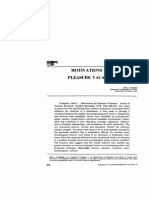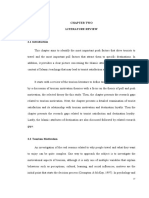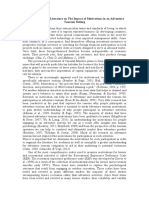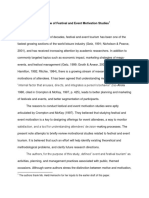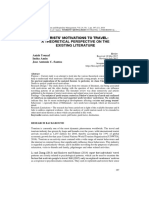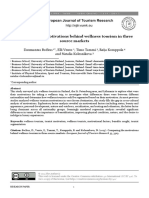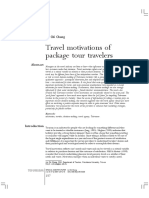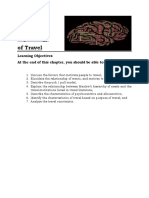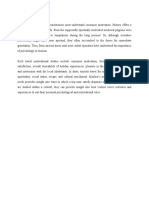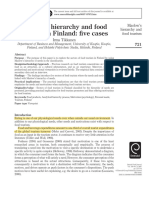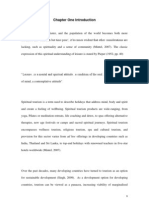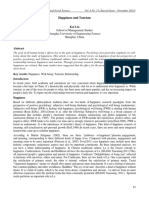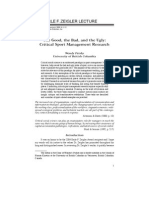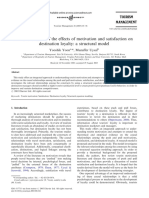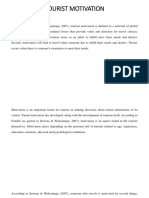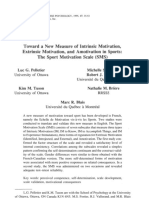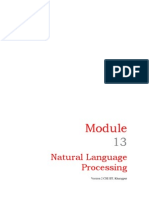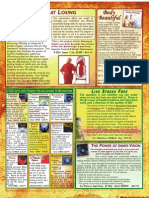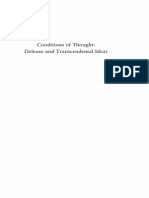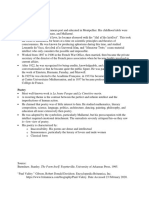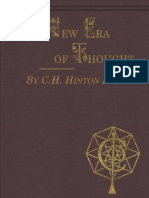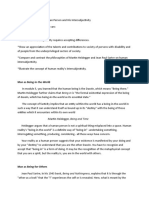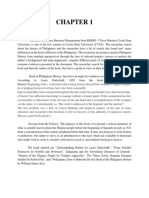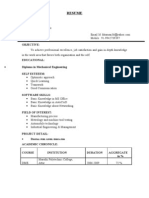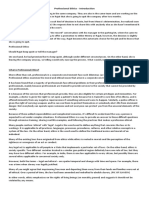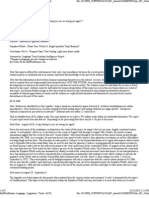Cassidy Sept 5 2005 Version
Cassidy Sept 5 2005 Version
Uploaded by
rgovindan123Copyright:
Available Formats
Cassidy Sept 5 2005 Version
Cassidy Sept 5 2005 Version
Uploaded by
rgovindan123Original Description:
Copyright
Available Formats
Share this document
Did you find this document useful?
Is this content inappropriate?
Copyright:
Available Formats
Cassidy Sept 5 2005 Version
Cassidy Sept 5 2005 Version
Uploaded by
rgovindan123Copyright:
Available Formats
WHAT MOTIVATES SPORTS EVENT TOURISTS?
A SYNTHESIS OF THREE
DISCIPLINES.
Frances Cassidy
University of Southern Queensland (USQ)
Toowoomba, Australia.
Abstract
Sport event tourism is a huge and growing global industry with important economic
implications for both the sport, the event and the impact of travel and tourism related benefits
on host destinations. Research within the tourism and event marketing fields reveal an
abundance of studies on motivation and satisfaction (Crompton 1979; Dann 1977; Uysal &
J urwoski 1994; Gnoth 1992; Wann & Branscombe. However there is a lack of research into
what motivates consumers to become sport event tourists and whether these motivations differ
from the traditional sport consumption, tourism or event marketing literature. This paper
synthesises the consumer motivation literature from three fields; tourism, events and sports
spectating. It further provides a proposal for future research which advocates the testing of a
new set of motivational variables and eventual identification of a sport event tourist typology.
Keywords: motivation, destinations, tourism, sports, events, motivation.
INTRODUCTION
The last decade has seen an increase in the number of sporting events held worldwide (Getz,
1998). These sporting events may appeal to a local market (Chinchilla Watermelon Festival
watermelon throwing contest) or a global level (Olympic Games). However, for any sporting
event to be successful it not only needs sports participants, it also needs spectators or
attendees (Gibson, 1998). Marketers need to be aware of and to appreciate the driving forces
which influence these spectators to take the time, effort and expense to be a spectators either
locally or internationally. Spectators will often combine their yearly holiday to coincide with
a sporting event and so there will be many influencing factors i.e. time of year, destination
and cost to name a few. This paper examines what motivates sport event tourists.
Literature review on motivations
To be motivated means to be moved to do something (Ryan & Deci, 2000). A person who has
no stimulus to act is thought to be unmotivated. On the other hand a person who is moved to
act is considered motivated. Motivation can vary from the levels of motivation (how much
motivation) and also the orientation of the motivation (what type of motivation).
Underlying all behaviour are needs and motivations, grounded in the basic physiological and
socio-psychological needs and wants of all humans. Some theories of motivation applied to
understanding sport, leisure and tourism behaviour are Murrays (1938) needs theory of
personality, Maslows (1943) hierarchical theory of needs and Berlynes (1960) concept of
optimal level of stimulation.
Murray (1913 p. 123) explained that A need is a stimulus a force pushing an individual in a
certain direction or to behave in a certain way. He identified 12 physiological needs which
are viewed as primary needs, and include air, water, food and security. He also identified 28
1
psychological needs which are considered secondary needs and are connected to mental or
emotional satisfaction.
The hierarchical theory of needs by Maslow (1943) is a well known theory on motivation and
like Murray (1913) suggested that peoples behaviour is driven by both physiological and
socio-psychological needs. However, Maslow had a more structured hierarchical order to the
needs of activation and satisfaction. He believed that the lower-order needs (psychological
needs followed by safety needs) had to be satisfied before an individual could work on the
higher-order needs of love, belongingness and self-esteem. At the top of the hierarchy of
needs is self-actualisation which is an opportunity for individuals to become everything that
one is capable of becoming (Maslow, 1943 p. 382).
Research using Murrays or Maslows theories into sport, tourism and leisure have found that
the relationship between needs and activity choice is quite complex (e.g. Driver & Knopf,
1977; Tinsley et al., 1977; Allen, 1982; Iso-Ahola & Allen, 1982; Pearce, 1982; Beard &
Bagheb, 1983; Pearce & Caltabiano, 1983; Mills, 1985). Research undertaken by both Murray
and Maslow has lead to the belief that behaviour is multidimensional and that the same
activity may be motivated by a variety of needs at different times for the one individual or
that one activity may have different meanings to another person at the same time (Crandell,
1980). No matter how complex the relationships may be the motivation theory still gives an
insight into why people choose to take part in certain activities i.e. being a sports event
tourist.
On the other hand Berlyne (1960) postulated that there are those individuals who prefer a very
stimulating situation/s and who seek out those activities that match their threshold for
stimulation. This could be reflected in the need to attend a high octane car race as a spectator.
There are also others who avoid situations which they feel are above their optimal level of
arousal. Islo-Ahola (1982) suggests that the optimal level of stimulation is a balance between
the need for stability and the need for variety. He notes that sport and tourism behaviour are
motivated by two forces; seeking and escaping. The escape motive would be predominant in
tourism behaviour because of travel away from the everyday environment. Because the
consumer chooses to take part in tourism and sport, they can select activities that match their
optimal levels of stimulation need i.e. being a sport event tourist.
Further research notes that motivation can be referred to as biological/psychological needs
and wants, including forces that arouse, direct and integrate a persons behaviour and activity
(Dann, 1981; Pearce, 1982; Uysal & J urowski, 1993). Various disciplines have been used to
explain the phenomena and characteristics related to motivation. However, the characteristics
are very complex as they relate to human beings and human nature which in itself is complex
(Chon,1989). Whilst in the disciplines of sociology and psychology, motivation is often
directed towards cognitive and emotional motives (Ajzen & Fishbein, 1977) or internal and
external motives (Gnoth, 1997). Internal motives are associated with feelings, instincts and
drives whereas external motives involve mental representations such as beliefs or knowledge.
MacCannell (1977) notes that from an anthropoligcal viewpoint, tourists are motivated to
escape the routine of daily life and seek authentic experiences. Whereas, from a socio-
psychological point of view, motivation is classified as seeking and avoidance (Iso-Ahola,
1982). It therefore appears that motivations can be linked to various disciplines and can be
represented in various ways depending on the sport event tourist.
2
A different theory for motivation proposed by Deci & Ryan (1985) is The Self-Determination
Theory (SDT) which differentiates between the various types of motivation which are based
on different reasons or goals that are followed by an action. Much research (Deci & Flaste,
1996; Sansone & Harackiewicz, 2000; Iwasaki & Mannell, 1999; Hennessy, 2003) has also
been undertaken on intrinsic and extrinsic motivation. Intrinsic motivation refers to doing
something because it is naturally interesting or enjoyable, while extrinsic motivation refers to
doing something because it leads to an independent outcome. The sport event tourist may fall
into either of these groups depending on their goals and motivation.
Motivation has often been considered the primary cause of peoples thoughts, feelings and
actions and refers to an activated state within a person which consists of drive urges, wishes
and desires which lead to goal-orientated behaviour (Mowen & Minor,, 1998). Motivating
factors in tourism can be divided into two groups. Firstly, those which motivate a person to
take a holiday and secondly those which motivate a person to take a particular holiday to a
specific destination at a particular time (Swarbrooke & Honer, 1999). Sports tourist would
pertain to the second group of tourists as they are travelling to a particular destination to
watch a particular sporting event at a certain time.
Beard and Ragheb (1983) developed a model called the Leisure Motivation Scale (LMS)
which tried to divide the motivators into four types based on the work of Maslow (1943). The
scale is divided into four sections. The first being the intellectual component which examines
the extent to which individuals are motivated to participate in leisure activities which involve
mental activities i.e. learning, exploring, discovery, thought or imagery. The second
component is the social component and it explores the extent to which individuals engage in
leisure pursuits for social reasons. This includes the two basic needs of friendship and
interpersonal activities. The third component is the competence-mastery section which
examines the extent to which individuals participate in leisure activities in order to master,
challenge or compete. The final component is the stimulus avoidance area which assess the
desire to escape and get away from lifes over stimulating situations. They seek solitude and
calm conditions to rest and unwind.
Whilst areas of the Leisure Motivation Scale are applicable to the tourism sector it should be
noted that every tourist is different and so are the factors which they are motivated by.
Swarbrooke & Horner (1999) suggest that there are six main motivating factors which
influence the potential traveller. They are; personality, lifestyle, past experience, past life,
perceptions and image. It is not likely that a potential traveller will be motivated by just one
factor rather they are more likely to be influenced by a number of factors at any one time.
While there are theoretical frameworks regarding independent motivational factors for sport
consumption, the research is fragmented and in some cases inconclusive . Hence there is
really little consensus on the boundaries of such theories.
As social creatures, people have the desire to be with others and this is known as the
affiliation motivation. Affiliation refers to developing and maintaining relations with others
(Handy 1993). Often spectators association with sport is motivated by a desire to confirm
their sense of identity. Donnelly and Young (1988) through their analysis of mountain
climbers and rugby players, detail a complicated process of identifying construction and
subculture affiliations. Researchers have noted that spectators can bring together people who
otherwise would have little in common (Kutcher, 1983; Melnick, 1983) and it can also instil a
feeling of national pride of a sense of community (Klein, 1984; Klein, 1991). Being with
3
others who enjoy the same activities is defined as social facilitation (McDonald, Milne, Hong,
2002). Spectators and participants alike are motivated by the opportunity of spending time
with family and friends. Studies by J amber (1999) and Weiss and Duncan (1992) show that
peer and family relations in a sport situation could motivate participant performance.
Motivation of sport attendees
Sports spectators are estimated to be worth millions of dollars to the global economy which
would suggest that they are a very valuable niche market segment which should be studied
and understood. There appears to be little agreement in the literature as to which factors (or
combinations) explain or predict the motives of sport spectators. Theories have been put
forward by various researchers (Duncan, 1983; Thomas, 1986: Smith, 1988; Sloan, 1985;;
Wann, 1995; Trail, Anderson & Fink, 2000), however there is little empirical evidence
available on any of the theories proposed by the above researchers.
This increase in sport tourism in recent years has been aided by advances in information
technology (IT), transportation and in the promotion of good health. Spectators have the
ability to get onto the Web and view first hand the conditions for a snowboard competition
and also to obtain competitive airfares to the destination. With improved transportation and
reliable services the spectators are able to travel easily and very affordably. However, there is
the need to find out what motivates people to become spectators and what motivates them to
travel to attend these events.
Motivational theories have also been developed by Sloan (1985) and they are categorized as
follows: salubrious effects theories, stress and stimulation seeking theories, catharsis and
aggression theories, entertainment theories, and achievement-seeking theories. Sloan (1985)
found that the salubrious effects theory suggests that involvement in sport is motivated by
pleasure and increased physical and mental well-being whereas stress and stimulation seeking
theories propose that when risk levels, stress and arousal fall below desired levels, organisms
will seek opportunities to increase arousal intensity. Sloan (1985) further suggests that the
catharsis and aggression theories indicate that participation in, or being a spectator or, acts of
aggression will either result in a reduction of aggression levels, or alternatively, increase the
aggression levels. The entertainment theories are linked to the attraction to sport based on the
aesthetic and moral representations derived from the meaning of the sports event. Finally,
achievement-seeking theories suggest that individuals fulfil their need for achievement
through athletic competition.
Whilst there are theoretical formulations regarding independent motivational factors for sport
consumption, the research is fragmented and in some cases inconclusive. Hence there is
really little consensus on the boundaries of such theories. Sloans (1985) review of sport
motivation literature suggests motivational factors which are traditionally used to explain
sport participation could be applied to sport spectatorship.
Motivations to attend events
There are many types of events. For example, special events, mega events, hallmark events
and major events. McDonnell et al.(1999) considers a special event to usually be one-off or
infrequent by nature. The special event could then be considered as a mega or hall mark
event. Getz (1997 p. 6) defines a mega event as:
Their volume should exceed 1 million visits, their capital costs should be at least $500
million, and their reputation should be of a must see event. Mega events, by way of their size
4
or significance, are those that yield extraordinarily high levels of tourism, media coverage,
prestige or economic impact for the host community or destination.
The definitions of various types of events all have one thing in common and that is, that they
are a reason to celebrate, to bring various groups or individuals together to experience what
the event has to offer. The event may last over several weeks or just a day. It may be a one
time or recurring event and it may be a public or private sector event. Whichever type of
event it is, there is the need to motivate people to take action to attend. Getz (1997) takes the
general approach that people attend events to satisfy various personal needs.
Now that the definitions have been explained it is time to review some of the motivations
which draw people to these events. There are several groups of motives proposed by
McDonnell et al. (1999). The four main groups proposed by McDonnell et al. (1999) are
social motives, organisational motives, physiological motives and personal motives.
Social motives may include the opportunity to experience social interaction with others or of
being part of the community spirit which takes place during an event. The event attendee may
feel so moved by their social motives that they want to partake of good deeds and may
become a volunteer at the event.
The second groups of motives are organisational motives. These generally include the need
for status or recognition that they have been part of the event. For example, there is status
and/or prestige connected with attending an event such as the Olympic Games. Organisational
motives also include sponsorship or community support. Organisations want to appear to be
supporting the community through their commitment to the event.
Physiological motives are the third group. These include the need for relaxation and or
exercise depending on the type of event. The attendee of the event expects to eat, drink and to
be entertained as part of the event process.
The final group is the personal motives. These motives can be different for each attendee.
Some of the personal motives could include the need to seek new experiences from the
everyday. It could be to fulfil an ambition to achieve something which the attendee has
always wanted to do i.e. attend the Passion Play in Oberammergau, Germany.
It should be noted that attending an event may be the result of many motives, not just one
motive from one group but several from various groups. These are issues which sport event
marketers or promoters should be very aware of.
Motivations of a tourist
A review of the literature on motivation shows that people travel because they are pushed
into making a travel decision by internal, psychological forces, and pulled by the external
forces of the destination attributes (Crompton, 1979; Dann, 1977; Uysal & J urowski, 1993).
Tourists obviously have their own internal and external reasons for travelling (McGee, Loker-
Murphy & Uysal, 1996). However, theses reasons could have positive or negative impacts on
travel satisfaction. Travel satisfaction as been used as a tool to assess the outcome of the
travel experience (Bramwell, 1998; Ross & Iso-Ahola, 1991). In tourism this concept of
motivation can be divided into two groups which indicate that people travel because they are
5
either pushed or pulled to do so by forces or factors (Dann, 1977; Dann, 1981). These factors
show how tourists are pushed by motivation variables into making travel decisions and then
how they are pulled or attracted by a destination attributes (Uysal & J urowski, 1993). So the
push motivations are related to the tourists desire, while the pull factors or motivations are
aliened with the attributes of the destination choice (Cha, McCleary & Uysal, 1995;
Crompton, 1979; Dann, 1981; Oh, Uysal & Weaver, 1995). Put simply the push motivations
are related to internal or emotional factors whilst pull motivations are connected to the
external, cognitive or situational factors. Crompton (1979) found that push motivations could
be grouped into the following areas; to escape, rest and relaxation, prestige, health and fitness,
adventure and social interaction, family togetherness and excitement. Tourists may travel to
escape the dreariness of their every day lives and to find authentic experiences. The pull
motivations are attributed to the destinations overall attractiveness. For example, beaches,
cultural attractions, natural scenery shopping and so forth. However these push and pull
factors may work together and the destination attributes may stimulate and reinforce inherent
push factors (McGee et al., 1996). Several research studies have been undertaken using these
perspectives (Iso-Ahola, 1982; Pyo, Mihalik & Uysal, 1989; Yuan & McDonald; 1990).
Further research by Iso-Ahola (1982) suggested that one perceived a leisure activity as having
the potential to produce satisfaction for two reasons. The first reason being that the leisure
activity may provide intrinsic rewards (such as mastery and competence) and secondly to
escape from routine life. In 1987 Kippendorf conducted similar research and found that
tourists are motivated by going away from rather than going toward something and that
tourist motivation is generally self-oriented.
It can therefore be seen that there are some similarities in motivational theory from various
disciplines which will impact on the sport event tourist.
Conclusion
This paper has discussed an overview on motivational theory and related it to sport attendees,
event attendees and tourists and has found that whilst there are many theories for each
independent group they have not specifically been linked to sports event tourists as a total
consumer group, The next step in this research is to undertake specific motivational research
on this specific consumer group and build a typology which will provide marketers with up-
to-date consumer information on this ever increasing market sector.
References
Allen, L. (1982). The relationship between Murray's Personality Needs and leisure interests.
Journal of Leisure Research, 14, 63-76.
Ajzen, I., & Fishbein, M. (1977). Attitude-behavior relations: a theoretical analysis and
review of empirical research. Psychological Bulletin, 84, 888-918.
Beard, J ., & Ragheb, M. (1983). Measuring leisure motivation. Journal of Leisure Research,
15, 219-228.
Berlyne, D. (1960). Conflict, arousal and curiosity. New York: McGraw-Hill.
Bramwell, B. (1998). User satisfaction and product development in urban tourism. Tourism
Management, 19(1), 35-47.
Cha, S., McCleary, K., & Uysal, M. (1995). Travel motivation of J apanese overseas travelers:
a factor-cluster segmentation approach. Journal of Travel Research, 31(1), 33-39.
Chon, K. (1989). Understanding recreational travelers' motivations, attitude and satisfaction.
The Tourist Review, 44(1), 3-7.
6
Crandell, L. (1987). The Social Impact ofTourism on Developing Regions and its
Management. In J . R. B. Ritchie & C. R. Goeldner (Eds.), Travel Tourism and
Hospitality Research (pp. 373-383). New York: Wiley.
Crompton, J . (1979). Motivations for pleasure vacation. Annals of Tourism Research, 6, 408-
424.
Dann, G. (1977). Anomie, Ego-enhancement and Tourism. Annals of Tourism Research, 4,
184-194.
Dann, G. M. (1981). Tourism motivations; an appraisal. Annals of Tourism Research, 8(2),
189-219.
Deci, E. L., & Ryan, R. (1985). Intrinsic Motivation and Self-Determination in Human
Behavior. New York: Plenum.
Deci, E. L., & Flaste, R. (1996). Why we do what we do: Understanding self motivation.
Victoria, Australia: Penguin Group.
Donnelly, P., & Young, K. (1988). The construction and confirmation of identity in Sport Sub
Cultures. Sociology of Sport Journal, 5, 223-240.
Driver, B., & Knopf, R. (1977). Personality, outdoor recreation, and expected consequences.
Environment and Behavior, 9, 169-193.
Duncan, M. C. (1983). The symbolic dimensions of spectator sport. QUEST, 35, 29-36.
Getz, D. (1997). Event Management and Event Tourism. New York: Cognizant
Communication Corporation.
Getz, D. (1998). Trends, stretegies, and issues in sport event tourism. Sport Marketing
Quarterly, 7(2), 8-13.
Gibson, H. (1998). Sport tourism: A critical analysis of research. Sport Management Review,
1, 45-76.
Gnoth, J . (1997). Tourism motivation and expectation formation. Annals of Tourism
Research(24), 283-304.
Handy, C. (1993). Understanding organisations. New York: Oxford University Press.
Hennessey, B. A. (2003). The Social Psychology of Creativity. Scandinavian Journal of
Educational Research, 47(3), 253-271.
Iso-Ahola, S. E. (1982). Towards a Social Psychological Theory of Tourism Motivation: A
Rejoinder. Annals of Tourism Research, 9, 256-262.
Iso-Ahola, S. E., & Allen, J . (1982). The dynamics of leisure motivation: the effects of
outcome on leisure needs. Research Quarterly for Exercise and Sport, 53, 141-149.
Iwasaki, Y., & Mannell, R. (1999). Situational and Personality Influences on Intrinsically
Motivated Leisure Behavior: Interaction Effects and Cognitive Processes. Leisure
Sciences, 21(4), 287-306.
J amber, E. A. (1999). Parents as children's socializing agents in youth soccer. Journal of
Sport Behavior, 22(3), 350-359.
Klein, A. M. (1991). Sugarball. New Haven: Yale University Press.
Krippendorf, J . (1987). Ecological Approach to Tourism Marketing. Journal of Tourism
Management, 8, 174-176.
Kutcher, L. (1983). The American sport event as carnival: An emergent norm approach to
crowd behavior. Journal of Popular Culture, 24, 121-136.MacCannell, D. (1977). The
tourist. New York: Schockon.
McDonald, M. A., Milne, G. R., & Hong, J . (2002). Motivational Factors for Evaluating Sport
Spectator and Participant Markets. Sport Marketing Quarterly, 11(2), 100-113.
McGee, N. G., Loker-Murphy, L., & Uysal, M. (1996). The Australian international pleasure
travel market: motivations from a gendered perspective. The Journal of Tourism
Studies, 7(1), 45-47.
7
Melnick, M. (1983). Searching for sociability in the stand: A theory of sports spectating.
Journal of Sport Management, 7, 44-60.
Oh, H. C., Uysal, M., & Weaver, P. (1995). Product bundles and market segments based on
travel motivations: a canonical correlation approach. International Journal of
Hospitality Management, 14(2), 123-137.
Pearce, P. L. (1982). The social psychology of tourist behavior. Oxford: Pergamon Press.
Pearce, P. L., & Caltabiano, M. (1983). Inferring travel motivation from traveler's experience.
Journal of Travel Research, 21, 16-20.
Pyo, S., Mihalik, B. J ., & Uysal, M. (1989). Attraction attributes and motivations: A canonical
correlation analysis. Journal of Tourism Research, 16, 277-282.
McDonnell, I., Allen, J ., & O'Toole, W. (1999). Festival and Special Event Management.
Brisbane: J ohn Wiley & Sons.
McGehee, N. G., Loker-Murphy, L., & Uysal, M. (1996). The Australian international
pleasure travel market: motivations from a gendered perspective. The Journal of
Tourism Studies, 7(1), 45-47.
Maslow, A. (1943). A Theory of Human Motivation. Psychological Review(50), 370-396.
Mowen, J . C., & Minor, M. (1998). Consumer Behaviour (5 ed.). Englewood Cliffs, NJ :
Prentice-Hall.
Murray, H. A. (1938). Exploration in Personality. New York: Oxford University Press.
Mills, A. (1985). Participation motivations for outdoor recreation: a test of Maslow's theory.
Journal of Leisure Research, 17, 184-199.
Ross, E., & Iso-Ahola, S. E. (1991). Sightseeing tourists' motivation and satisfaction. Annals
of Tourism Research, 18(2), 226-237.
Ryan, R., & Deci, E. L. (2000). Intrinsic and Extrinsic Motivations: Classic Definitions and
New Directions. Contemporary Educational Psychology, 25, 54-67.
Sansone, C., & Harackiewicz, M. (2000). Intrinsic and Extrinsic Motivation: The Search for
Optimal Motivation. San Diego, California: Academic Press.
Sloan, L. R. (1985). The motives of sport fans. In J . H. Goldstein (Ed.), Sports, Games and
Play:Social and Psychological Viewpoints (pp. 175-240). Hillsdale: Lawrence
Erlbaum Associates.
Smith, G. J . (1988). The noble sports fan. Journal of Sport and Social Issues, 12(1), 54-65.
Swarbrooke, J ., & Horner, S. (1999). Consumer Behaviour in tourism. London: Butterworths-
Heinemann.
Thomas. (1986). In Preliminary Validation of Sport Fan Motivation Scale. Journal of Sport &
Social Issues, 19(4), 337-348.
Tinsley, H., Barrett, T., & Kass, R. (1977). Leisure activities and need satisfaction. Journal of
Leisure Research, 9, 111-120.
Trail GT, Anderson DF, & Fink J S. (2000). A Theoretical model of sport spectator
consumption behavior. International Journal of Sport Management, 1, 154-180.
Uysal, M., & J urowski, C. (1993). Testing the push and pull factors. Annals of Travel
Research, 21(4), 844-846.
Wann, D. L. (1995). Preliminary Validation of Sport Fan Motivation Scale. Journal of Sport
& Social Issues, 20, 377-396.
Weiss, M. R., & Duncan, S. C. (1992). The relationship between physical competence and
peer acceptance in the context of children's sports participation. Journal of Sport
and Exercise Psychology, 14, 177-191.
Yuan, S., & McDonald, C. (1990). Motivational determinants of international pleasure time.
Journal of Travel Research, 29(1), 42-4
8
You might also like
- Motivations For Pleasure Vacation: John L. CromptonDocument17 pagesMotivations For Pleasure Vacation: John L. CromptonTitas Khan100% (3)
- Beard & Ragheb (1983) - Measuring Leisure MotivationDocument11 pagesBeard & Ragheb (1983) - Measuring Leisure MotivationHuyen T. T. Nguyen100% (1)
- Reading Images - The Grammar of Visual Design PDFDocument6 pagesReading Images - The Grammar of Visual Design PDFDesirée Suzuki0% (1)
- Motivation On Nature Based TourismDocument12 pagesMotivation On Nature Based TourismAyu LarasatiNo ratings yet
- 2literature Review On Theories of MotivationDocument21 pages2literature Review On Theories of MotivationSiddharth DevnaniNo ratings yet
- Allen, Greenlees & Jones (2013)Document47 pagesAllen, Greenlees & Jones (2013)gan publishingNo ratings yet
- OTL Vs CTLDocument3 pagesOTL Vs CTLkavitaNo ratings yet
- Chapter Two Literature ReviewDocument80 pagesChapter Two Literature ReviewAliNo ratings yet
- Unit 5 - Push and Pull FactorsDocument4 pagesUnit 5 - Push and Pull Factorskimjoe.osborneNo ratings yet
- Motivation and Tourism - UnlockedDocument15 pagesMotivation and Tourism - UnlockedWiwidNpswsNo ratings yet
- Tourism Information and Pleasure MotivationDocument21 pagesTourism Information and Pleasure MotivationZhixing WeiNo ratings yet
- Review On Related Literature On Adventure TourismDocument3 pagesReview On Related Literature On Adventure TourismDiane MarananNo ratings yet
- 24-27 Manlangit 1Document5 pages24-27 Manlangit 1Nia Rose BalungagNo ratings yet
- Makalah Bahasa InggrisDocument6 pagesMakalah Bahasa InggrisFatur RahmNNo ratings yet
- Motivation of NAture TourismDocument10 pagesMotivation of NAture TourismAliNo ratings yet
- Micro Draft PDF 1 PDFDocument90 pagesMicro Draft PDF 1 PDFRenaliz GonzalesNo ratings yet
- Recreation Management Research On Recreational Motivation and ExperienceDocument8 pagesRecreation Management Research On Recreational Motivation and ExperienceaijbmNo ratings yet
- A Review of Festival and Event Motivation StudiesDocument16 pagesA Review of Festival and Event Motivation StudiesMORDENO, JOHN GABRIEL O. SCINo ratings yet
- Exploring Origins of InvolvementDocument28 pagesExploring Origins of InvolvementPabune WolvsterNo ratings yet
- Du lịchDocument15 pagesDu lịchThư TốngNo ratings yet
- 2018religionandspiritualityinsport OxfordResEncofPsychDocument23 pages2018religionandspiritualityinsport OxfordResEncofPsych01200275No ratings yet
- Comparing The Motivations Behind Wellness Tourism in Three Source MarketsDocument23 pagesComparing The Motivations Behind Wellness Tourism in Three Source Markets005AASHI JAINNo ratings yet
- 352-Article Text-611-1-10-20210406Document18 pages352-Article Text-611-1-10-20210406justhoneyworksNo ratings yet
- Micro Perspective of Tourism and Hospitality Industry Activity 1 AsynchronousDocument1 pageMicro Perspective of Tourism and Hospitality Industry Activity 1 AsynchronousNico TrinidadNo ratings yet
- Travel Motivations of Package Tour Travelers: Jui Chi ChangDocument20 pagesTravel Motivations of Package Tour Travelers: Jui Chi ChangNông Đức ThắngNo ratings yet
- Unit 1 Travel Motivation and ProfileDocument9 pagesUnit 1 Travel Motivation and ProfileLyleNo ratings yet
- A Study On Traveler Expectation, Motivation and AttitudeDocument18 pagesA Study On Traveler Expectation, Motivation and AttitudeAdrian AgoesNo ratings yet
- Chapter 1 The Psychology of TravelDocument14 pagesChapter 1 The Psychology of TravelJenny Mar DaenosNo ratings yet
- Why People GambleDocument17 pagesWhy People GamblegorgiasNo ratings yet
- 2006 SprayWangBiddleChat EJSSDocument9 pages2006 SprayWangBiddleChat EJSSannizukaNo ratings yet
- 04 Polgar Motivation For Pink TourismDocument15 pages04 Polgar Motivation For Pink TourismOnur YamanNo ratings yet
- Donahue 2009Document9 pagesDonahue 2009AhmadTharmiziDamitNo ratings yet
- Why People Gamble PDFDocument17 pagesWhy People Gamble PDFgorgiasNo ratings yet
- Statement of The Problem 1. What Are The Reasons That Motivates Filipino To Travel Around? 2. What Do They Gain From Traveling?Document4 pagesStatement of The Problem 1. What Are The Reasons That Motivates Filipino To Travel Around? 2. What Do They Gain From Traveling?Cyra Eve HelisNo ratings yet
- IntroductionDocument15 pagesIntroductionTitas KhanNo ratings yet
- How Do Leisure Activities Contribute To Subjective Well-BeingDocument11 pagesHow Do Leisure Activities Contribute To Subjective Well-BeingMihail RonnyNo ratings yet
- Maslows Hierarchy and Food Tourism in FinlandDocument14 pagesMaslows Hierarchy and Food Tourism in FinlandschagalakaNo ratings yet
- Ijerph 15 00953Document16 pagesIjerph 15 00953Fatima Delgado MotañezNo ratings yet
- The Psychology of TourismDocument11 pagesThe Psychology of TourismBridget DominguezNo ratings yet
- Psychology Chapter 5Document9 pagesPsychology Chapter 5qn8tgp4xqgNo ratings yet
- FIPA UNIT 3 NOTES - Google DocsDocument14 pagesFIPA UNIT 3 NOTES - Google Docsmanshakapoor05No ratings yet
- Impacts of Gambling on Students’ LifeDocument22 pagesImpacts of Gambling on Students’ Lifefununiversity007No ratings yet
- Who Decides Our Preferences?Document2 pagesWho Decides Our Preferences?Alina GaitaNo ratings yet
- Micro MidtermsDocument81 pagesMicro Midtermsalmirasvt17No ratings yet
- MICRO PERPECTIVE Lesson 1Document4 pagesMICRO PERPECTIVE Lesson 1Cymhon BayogNo ratings yet
- Final DiseertationDocument91 pagesFinal DiseertationTulshi NaikNo ratings yet
- Happiness and TourismDocument4 pagesHappiness and TourismTran QuyetNo ratings yet
- Redefining The Motivational Concepts Among Volunteers in The Context of The PhilippinesDocument68 pagesRedefining The Motivational Concepts Among Volunteers in The Context of The PhilippinesJose PlazaNo ratings yet
- Introduction to Sports Fan MotivationDocument13 pagesIntroduction to Sports Fan MotivationWei Zie LowNo ratings yet
- Tourism and Consumer Behavior: Prepared By: Mary Jane D. Reyes, LPT, MaedDocument12 pagesTourism and Consumer Behavior: Prepared By: Mary Jane D. Reyes, LPT, MaedTricia Mae TalplacidoNo ratings yet
- Segmentation of Rural Tourists: Combining Push and Pull MotivationsDocument14 pagesSegmentation of Rural Tourists: Combining Push and Pull MotivationsIvanBučevićNo ratings yet
- The Good, The Bad and The Ugly - Wendy FrisbyDocument13 pagesThe Good, The Bad and The Ugly - Wendy FrisbyGavin WeedonNo ratings yet
- Multifaceted Nature of Intrinsic Motivation PDFDocument15 pagesMultifaceted Nature of Intrinsic Motivation PDFJoshua RobertsonNo ratings yet
- SEM Sample ArticleDocument12 pagesSEM Sample ArticlesuryagcNo ratings yet
- 10.4324 9781315745664-29 ChapterpdfDocument9 pages10.4324 9781315745664-29 Chapterpdfnandini.jindiaNo ratings yet
- Adventure TravellerDocument14 pagesAdventure TravellerBiren100% (3)
- Kelompok 6 Bab 3 Tourist MotivationDocument9 pagesKelompok 6 Bab 3 Tourist MotivationAnneyNo ratings yet
- Sport TourismDocument10 pagesSport TourismBalan GeorgeNo ratings yet
- Scala PDFDocument19 pagesScala PDFAndreea GligorNo ratings yet
- Bernache Assollant Et Al 2011 Identity Crossbreeding in Soccer Fan Groups A Social Approach The Case of MarseilleDocument29 pagesBernache Assollant Et Al 2011 Identity Crossbreeding in Soccer Fan Groups A Social Approach The Case of Marseillevs8rpg2jfbNo ratings yet
- Unit 4: Travel Motivations: OutcomesDocument16 pagesUnit 4: Travel Motivations: OutcomesBj Apostol QuejaNo ratings yet
- Triggers of Aggression in Crowds; The Milieu of High School FootballFrom EverandTriggers of Aggression in Crowds; The Milieu of High School FootballNo ratings yet
- Calculation (Formula) : Current LiabilitiesDocument1 pageCalculation (Formula) : Current Liabilitiesrgovindan123No ratings yet
- Bone Graphic NovelsDocument12 pagesBone Graphic Novelsrgovindan123No ratings yet
- February 2014 Occupancy Publication RevisedDocument3 pagesFebruary 2014 Occupancy Publication Revisedrgovindan123No ratings yet
- Etc Venues 155 Bishopsgate Local HotelsDocument1 pageEtc Venues 155 Bishopsgate Local Hotelsrgovindan123No ratings yet
- Analysys Mason Microsoft Nokia Deal Sept2013 RDMM0Document2 pagesAnalysys Mason Microsoft Nokia Deal Sept2013 RDMM0rgovindan123No ratings yet
- Hotel List 2014Document2 pagesHotel List 2014rgovindan123No ratings yet
- Personal Statement GuideDocument4 pagesPersonal Statement Guidergovindan123No ratings yet
- Li-Wen Hsieh, National Taipei University Tracy L. Wisdom, USA Field HockeyDocument1 pageLi-Wen Hsieh, National Taipei University Tracy L. Wisdom, USA Field Hockeyrgovindan123No ratings yet
- Case1 1Document3 pagesCase1 1rgovindan123No ratings yet
- 2009 North American Society For Sport Management Conference (NASSM 2009) Dimensions of General Market Demand Associated With Professional Team Sports: Development of A ScaleDocument2 pages2009 North American Society For Sport Management Conference (NASSM 2009) Dimensions of General Market Demand Associated With Professional Team Sports: Development of A Scalergovindan123No ratings yet
- Implementation of A Dossier-Based Submission Process in A Senior Design Project CourseDocument2 pagesImplementation of A Dossier-Based Submission Process in A Senior Design Project Coursergovindan123No ratings yet
- Outline Writing GuideDocument1 pageOutline Writing Guidergovindan123No ratings yet
- A Look at Key Issues and Emerging Solutions: Brand ArchitectureDocument2 pagesA Look at Key Issues and Emerging Solutions: Brand Architecturergovindan123No ratings yet
- The Link Between Standardization/Adaptation of International Marketing Strategy and Company PerformanceDocument12 pagesThe Link Between Standardization/Adaptation of International Marketing Strategy and Company Performancergovindan123No ratings yet
- Natural Language ProcessingDocument7 pagesNatural Language ProcessingAsim Arunava Sahoo75% (4)
- Chapter 1Document13 pagesChapter 1AokiNo ratings yet
- Agile and ScrumDocument41 pagesAgile and ScrumsyaNo ratings yet
- Winning at LosingDocument1 pageWinning at LosingheartwithsoulNo ratings yet
- Book Review of Corporate Chanakya by MR Radhakrishnan PillaiDocument3 pagesBook Review of Corporate Chanakya by MR Radhakrishnan PillaiLakshmi Prasanna KalahastriNo ratings yet
- Social Work Statistics and MethodsDocument4 pagesSocial Work Statistics and MethodsDennis Mohammed100% (3)
- Daniela Voss - Conditions of Thought - Deleuze and Transcendental IdeasDocument294 pagesDaniela Voss - Conditions of Thought - Deleuze and Transcendental IdeasEnte Existente100% (1)
- A Very Brief Measure of The Big-Five Personality DomainsDocument25 pagesA Very Brief Measure of The Big-Five Personality DomainsFirdaus RamlanNo ratings yet
- Dealing With People You Can't Stand PresentationDocument43 pagesDealing With People You Can't Stand PresentationAD Stratego100% (3)
- 360 Degree FeedbackDocument16 pages360 Degree Feedbackmoanabianca6885No ratings yet
- Paul Valéry (1871-1945) : LifeDocument4 pagesPaul Valéry (1871-1945) : Lifeapi-357156106No ratings yet
- Hinton - A New Era of ThoughtDocument276 pagesHinton - A New Era of ThoughtCelephaïs Press / Unspeakable Press (Leng)100% (16)
- Module 9Document8 pagesModule 9Guin leeNo ratings yet
- Habit Canvas 3.0 Personilized PDFDocument4 pagesHabit Canvas 3.0 Personilized PDFReshmi Varma100% (1)
- Hay MC Ber (Competencias) PDFDocument12 pagesHay MC Ber (Competencias) PDFLuis Alfredo Mejias CastroNo ratings yet
- Four Pillars of LearningDocument2 pagesFour Pillars of LearningClea Allosa JunillerNo ratings yet
- CH 12 The Creative Side and Message StrategyDocument5 pagesCH 12 The Creative Side and Message StrategyLeigh_Holmes9248No ratings yet
- Harish Kumar .R Reg - No:11msb0050Document12 pagesHarish Kumar .R Reg - No:11msb0050Maruko ChanNo ratings yet
- The Knowing Doing Gap PDFDocument8 pagesThe Knowing Doing Gap PDFMart Dumali SambaludNo ratings yet
- Intro Phil HistoryDocument1 pageIntro Phil HistoryJunry AmadeoNo ratings yet
- Karnanan (New)Document3 pagesKarnanan (New)Cheenu RaghavNo ratings yet
- Book Summary by Bill Hammack: by Chip Heath and Dan Heath (Random House, 2007)Document4 pagesBook Summary by Bill Hammack: by Chip Heath and Dan Heath (Random House, 2007)christiansmilawNo ratings yet
- Poverty&Ut FrenchDocument119 pagesPoverty&Ut FrenchomaneramziNo ratings yet
- Professional EthicsDocument7 pagesProfessional EthicsLy NnethNo ratings yet
- ThesisDocument121 pagesThesisavatarnykoNo ratings yet
- High, Clif - ALTA Report Vol. 12 - 5 - Part 4 (2012.08.26) (Eng) (PDF) (307FOUR)Document9 pagesHigh, Clif - ALTA Report Vol. 12 - 5 - Part 4 (2012.08.26) (Eng) (PDF) (307FOUR)Deckard666No ratings yet
- Family: Regie Gonzaga Elladora Xi Humss - Prophet JeremiahDocument1 pageFamily: Regie Gonzaga Elladora Xi Humss - Prophet JeremiahRegie GonzagaNo ratings yet
- Body Scan Meditation OrigDocument2 pagesBody Scan Meditation OrigZissis JuziusNo ratings yet
